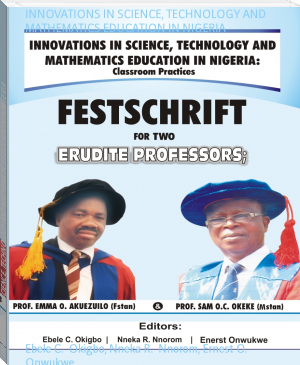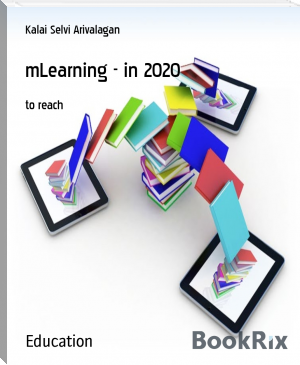INNOVATIONS IN SCIENCE, TECHNOLOGY AND MATHEMATICS EDUCATION IN NIGERIA, Ebele C. Okigbo, Nneka R. Nnorom, Ernest O. Onwukwe [best reads .TXT] 📗

- Author: Ebele C. Okigbo, Nneka R. Nnorom, Ernest O. Onwukwe
Book online «INNOVATIONS IN SCIENCE, TECHNOLOGY AND MATHEMATICS EDUCATION IN NIGERIA, Ebele C. Okigbo, Nneka R. Nnorom, Ernest O. Onwukwe [best reads .TXT] 📗». Author Ebele C. Okigbo, Nneka R. Nnorom, Ernest O. Onwukwe
Overloaded curriculum/Syllabus and inadequate time: syllabus to be covered is too wide in relation to time allowed for both the theoretical and practical aspect of topics in some subjects like chemistry. It is no doubt that an unwieldy and too demanding syllabus creates a lot of tension in both teachers and learners. Therefore LCIA demands huge time and attention, which most teachers of higher institutions in Nigeria do not have. Rigid lecture timetable also might not allow the flexibility of LCIA to take place on our institutions. Also the volume of administrative or non-administrative work some teachers have to cope with may hinder them from planning properly for their lessons which may pose a serious setback on the effective application of LCIA.
Most science teachers do not have a functional understanding of the changing nature, scope and development in science (chemistry, physics and biology). Some science teachers do not have current information because they do not belong to any science education professional body like the Science Teachers Association of Nigeria (STAN) or attend conference and workshops. Such teachers find it more convenient in staying away from current books and journals: so they go ahead to churn on outdated and a recycled notebook or lesson note thereby producing students that can only appreciate the benefit of science from only material infrastructural development in society. This invariably affects the learners’ involvement and active participation during teaching and learning.
Non-professionalism is another major challenge facing the application of LCIA in Nigeria tertiary institutions. Some teachers are teaching courses they do not specialize on, this will make them not to impact the knowledge appropriately and students will automatically become passive which is against the tenets of LCIA.
Poor remuneration and poor staff welfare has destroyed the morale of most teachers in Nigeria tertiary institutions. For instance science teachers in Nigeria do a lot of work, which involves both teaching and practical work, which they should/need to be rewarded bountifully, but at the end they are rewarded with little amount of money as their salaries. This will now condition them to engage in other ventures to achieve/solve their personal and family problems to the detriment of their teaching/profession. From the forgoing, it is obvious that the factors examined will go a long way in determining effective application of LCIA mostly at the tertiary institutions in Nigeria and even beyond.
Conclusion
Tertiary institution is the highest educational institution in Nigeria, therefore is the highest institution saddled with the responsibility of inculcating its citizens with the requisite skills that will make them employable. Improving the employability skill of chemistry graduates using learner-centred instruction approach is very significant. This chapter has proved that LCIA is a better approach to use towards developing necessary competence for employability, especially for Chemistry learners/graduates. Skills and employability skills for chemistry learners were pointed out with emphasis on meeting the needs of employers in the modern global workplace. Learners play a major role in LCIA. They are active participants in the learning process. It is observed that if the tertiary institutions in Nigeria are encouraged with the necessary resources for the effective application and implementation of LCIA, our graduates will be better fortified and equipped to be self-reliant and employers of labor without waiting for the government or private organizations to provide them with a job.
Implication of the Study
This study has provided evidence for the use of LCIA in improving the employability skill of chemistry graduates. The findings of this study have relevant educational implications to students, teachers and education sectors of State and Federal Government of Nigeria, to mention but a few.
The use of LCIA makes the students to be actively involved during learning which is among the major principles of learning. This approach gives the student the opportunity to be self-reliant, thus enhancing their problem solving skills. Students learn better when they are actively involved in a lesson. The study has also proved that students find it difficult to learn effectively and acquire employability skills when conventional lecture method is used. This is because when conventional lecture method is used, students become only listeners, observers and note copiers thereby become inactive during teaching and learning.
Since LCIA have been proved to enhance students’ employability skills, the findings will make chemistry teachers/lecturers to be much aware that using the LCIA could serve as strong basis for improving students’ employability skills. It will also motivate chemistry lecturers to put in their best to ensure that students are encouraged and exposed to the use of LCIA so that they can acquire the needed employability skills.
The implication of this study to Educational sectors of State and Federal Government of Nigeria, is that it will serve as an eye opener to most tertiary institutions offering science education programmes and chemistry in particular which may redirect them towards incorporating LCIA as part of the instructional strategies that students teachers would be trained on during their preparation processes as prospective science/ chemistry teachers.
Recommendation
It is therefore recommended among others that:
Learners should be motivated and improve in their participation of LCIA.
Conscientiously the teacher must of necessity, provide enabling environment and other resources necessary for implementation of LCIA. To achieve LCIA in Nigerian tertiary institutions requires the use of various learners-centred approaches with which the teacher should be acquainted.
Entrepreneurial/activity-oriented lessons should be embarked upon by chemistry lecturers so as to fully engage their students in a bid to maximally explore their potentials thereby enhancing their employability skills.
Government should provide well equipped chemistry laboratories in all higher institutions; this will help to facilitate learning especially where LCIA is to be used.
Aggressive sensitization and enlightenment programmes should be mounted by all concerned stakeholders aimed at highlighting the need for our graduates to acquire the requisite employability skills before graduating.
References
Ajaero, O. & Okoroafor, S. (2018) Enhancing Employability of Accounting Graduates through student-centred learning. Effective Teaching and Learning: A handbook for Educators in Nigerian Universities. Funai Press, Federal University Ndufu-Alike, Ikwo, Ebonyi Statepg.159-166.
Anyanwu, S.U. (2001). Principles and methods for classroom teaching. Owerri, Jeo Mankpa’s Publishers.
Bruner, J. (1966). Toward a theory of instruction. Cambridge, MA: Harvard University Press.
Eison, J. (2010). Using Active Learning Instructional Strategies to Create Excitement and Enhance Learning. Retrieved from https://www.cte.cornell.edu/documents/resentations/Eisen-handout.pdf
Eze, C.C. (2010). Repositioning chemistry education in Nigeria colleges of education for economic empowerment. 51st Annual Conference Proceedings of STAN 287-292
Hawati, J., Ruzite, A. R., Aisyah, A. R., Noor, A. A., Noor, A. H., & Muhamad, Z. Y. (2013). Integrating Student-Centered learning in Finance Courses: The Case of a Malaysian Research University. International Education Studies, 6 (6);108-123
Hornby, A.S. (2010). Oxford advanced learners dictionary (international students edition) 8th ed. New york; Oxford University Press.
Njelita, C.B., Egolum, E.O. & Ezeokeke K.N.C. (2014).Identification of production skill possessed by the chemistry teacher and those acquired by students for wealth creation. International Journal of Engineering and Science 3, (3); 15-23.
Ogunbiyi J.A., Ugodulunwa C.A., Eze A., Uwaleke C.C., Igu C.N.N., Ogba F.N. & Ekechukwu L.E. (2019). Effect of persuasive communication on students’ mathematics test anxiety, attitude and achievement in Nigerian air force secondary schools. American-Eurasian Journal of Agricultural & Environmental Sciences (AEJAES),19 (4); 269-262 IDOSI publications.
Okeke, M.I. (2015). Production focus for skill acquisition and entrepreneurship development. SppSyfey prints.
Omiko, A. (2015). Laboratory teaching: implication on students’ achievement in chemistry in secondary schools in Ebonyi state of Nigeria. Journal of Education and Practice: Available Online using www.Iiste.Org Issn 2222-1735 (Paper) Issn 2222-288x (Online) 6, No.30, 2015
Osisioma, I. (2012). Re-Imagining the Nigerian science and technology child with skills and competencies to succeed in the competitive global community .IJERD. International Journal of Education Research and Development, 4, (1); 13-21.
Palanissamy, A., Syed, R. T., & Kumar, P. (2017).Benefits’ of Implementing a Student-centred Learning Approach-A Study. Quality Management & Enhancement in Higher Education. OQNHE Conference 2017, Muscat, 21-22 March
Sternberg, R.J. (2007). Wisdom, production skill, intelligence, and creativity synthesized. New York: Cambridge University Press.
Terwase, T.N., Ugodulunwa C.A., Bulus, C.H., Ekechukwu, L.E., Uwaleke, C.C., Ogba F.N., Igu, C.N.N., & Eze, A. (2019). Diagnostic assessment of students’ achievement in automobile electric works in technical colleges in a developing country. American-Eurasian Journal of Agricultural & Environmental Sciences(AEJAES),19 (4); 233-241. IDOSI publications.
Udosen, E.D (2015). Concepts in environmental chemistry. Kalaba, Anikzo Global Ventures.
Uwaleke, C.C., Offiah, F.C., & Okechukwu I.E, (2014).Identification of the analytical skill level of secondary school chemistry students in Imo State of Nigeria. International Journal of Education, Science and Public Policy in Africa (IJESPPA), 4(1);47-55
PROXIMATE ANALYSIS AND HEAVY METAL INDEX OF ALLIGATOR PEPPER (Aframomum Melegueta)
Dr. U.G. Augustina Okeke
&
D. Chinenye Eje
Abstract
The proximate analysis and heavy metal index of alligator pepper (Aframomum Melegueta) were evaluated. The alligator peppers were bought from Ose Okwuodu market, Onitsha in Anambra State. The method approved by the Association of Analytical Chemist (2010) was adopted for the proximate analysis while Atomic Absorption Spectrophotometer was used for heavy metal index.
The result showed that alligator pepper content 65.31% carbohydrate and all content of 2.6%. Other proximate include moisture content 12.65%, crude fat, 3.9, crude fibre 12.74 and crude protein 2.8.
In addition mecury (0.15 ppm and lead 0.17ppm are above the WHO acceptable limit, 0.50 pmm and 0.30 ppm respectively. The level of the heavy metal index is Arsenic (Ar) > Lead (Pb) > Mercury (Hg)>Cadium. In conclusion, the alligator pepper from Ose market Onitsha, has highest content by Carbohydrate and least content of ash. While the Hg and Pb content is above the acceptable standard of WHO.
Keywords: Alligator pepper, Heavy metal, Melegueta pepper, gimmy pepper, guinea pepper.
Introduction
Alligator pepper is a popular herbaceous perennial plant that is originally from West Africa in countries like Nigeria, Cameroon, Liberia, Ghana etc. It belongs to the Zingiberaceae or ginger family and three namely in swampy habitats in West African Coasts. It is a common ingredient in West African cuisine, where it imparts both pungency and a spicy aroma to classic West African soups (stews). It is also an expensive spice so it’s sparingly used often (Celtnet Spice Guide, 2007).
In Igbo land, alligator pepper commonly known as ‘oseoji’ together with kola nuts are used in naming ceremonies, as presentation to visiting guests and for other social events with the kola nut rite. Alligator pepper is served with kola nut because of the hot spicy taste which enhances or reduces the bitter taste from the kola nut (Wikipedia, http://en. Wikipedia.org/ wiki/kolanut).But in Yoruba culture, according to Inegbenebor (2009), when new babies are born in Yoruba land, they are given small taste of alligator pepper (atare) shortly after birth which is the part of the routine baby wellowing process. Many tribes consume alligator pepper in different occasions and there is need to know exactly the constituent of this alligator pepper.
Alligator pepper is a very popular spice used mainly as food, in brewing and in vertinary and traditional medicine (Igwe et al, 1999). It also had also been traditionally used mostly for digestive and intestinal health.
Aframomum Melegueta seeds tend to have the following health medicinal properties such as antimicrobial, purgative, galactagogue, anthelmintic and haemostatic properties (Famuyide et al., 2011). Its seed also has some repellent properties. The spice is used in West Africa for the purpose of alleviating stomach ache and diarrhoea as well as hypertension with some limited reports on it being used for tuberculosis (Doherty et al., 2010) and a remedy for snake bites and scorpion stings (Edeoga et al., 2005). Aframomum Melegueta has a strong pungent peppery taste; this is as a result of the aromatic ketones and high tannin content. However, the seeds are highly valuable because of its medicinal and nutritional value. ThePhytochemical derived from its seed are being used since ancient time for treating several diseases ( Chiejina & Ukeh, 2012).
Many researchers like Chejina and Ukeh (2012) in their reviews, presented the phytochemicals in alligator pepper. Owing to the high consumption of alligator pepper by many people in various levels such as entertainment, medicinal and traditional there is need to analyse the proximate content of





Comments (0)